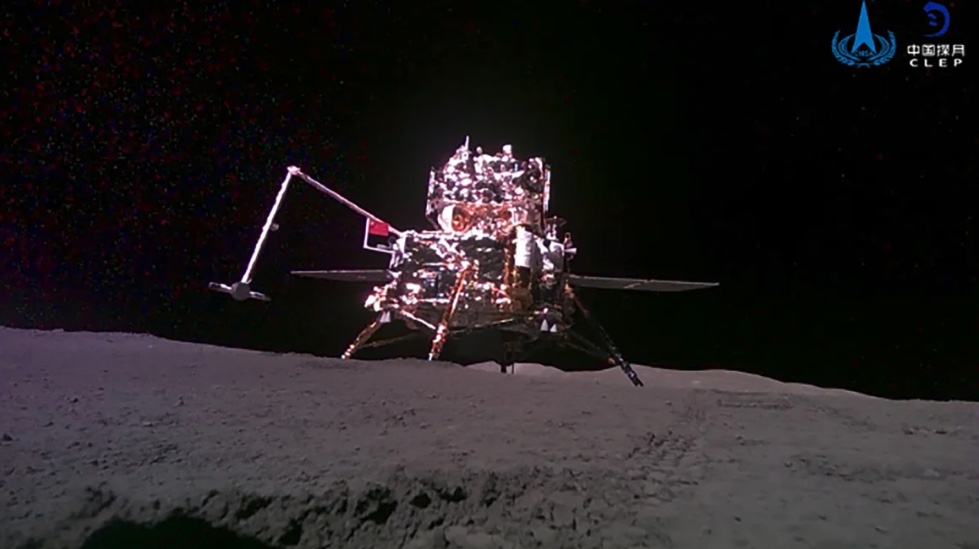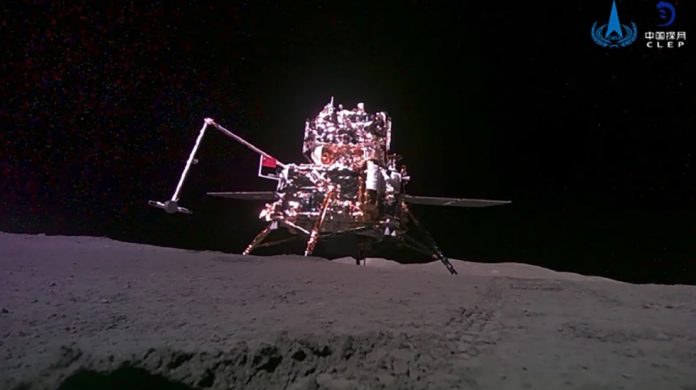ยานสำรวจดวงจันทร์ฉางเอ๋อ-6 ของจีนออกเดินทางจากอีกด้านของดวงจันทร์เมื่อวันอังคาร ถือเป็นความก้าวหน้าครั้งสำคัญในภารกิจอันทะเยอทะยานที่เน้นย้ำถึงการผงาดขึ้นมาของประเทศในฐานะมหาอำนาจด้านอวกาศ มีรายงานว่าจีนกลายเป็นประเทศแรกที่แสดงธงประจำชาติที่ด้านไกลของดวงจันทร์ซึ่งหันหน้าออกจากโลกด้วยการแสดงท่าทางเชิงสัญลักษณ์ก่อนการขึ้นบิน ยานสำรวจดังกล่าวซึ่งบรรทุกหินบนดวงจันทร์เริ่มแรกที่เคยเก็บมาจากอีกด้านของดวงจันทร์ ได้ปล่อยและเข้าสู่วงโคจรดวงจันทร์เมื่อช่วงเช้าวันอังคารตามเวลาปักกิ่ง
การดำเนินการนี้เกิดขึ้นหลังการเก็บตัวอย่างที่ประสบความสำเร็จในช่วงสองวันก่อนหน้า ดังรายละเอียดในแถลงการณ์ขององค์การบริหารอวกาศแห่งชาติจีน China National Space Administration (CNSA) มีการคาดว่ายานสำรวจฉางเอ๋อ-6 จะกลับมายังโลกประมาณวันที่ 25 มิถุนายน หลังจากใช้เวลาเดินทาง 3 สัปดาห์จากด้านไกลของดวงจันทร์ การเก็บตัวอย่างที่ประสบความสำเร็จของจีนตอกย้ำถึงความสามารถที่เพิ่มขึ้นในการสำรวจดวงจันทร์ ท่ามกลางสิ่งที่หัวหน้า NASA Bill Nelson อธิบายว่าเป็น “การแข่งขันในอวกาศ” ใหม่ ภารกิจนี้เป็นไปตามภารกิจฉางเอ๋อ 5 ของจีน ซึ่งเก็บตัวอย่างจากด้านใกล้ของดวงจันทร์ในปี 2563 ยานสำรวจซึ่งมีแขนกลทำหน้าที่รวบรวมดินและหินโดยการเจาะเข้าไปในพื้นผิวดวงจันทร์ พร้อมชูธงชาติจีนเมื่อเสร็จสิ้น รายงานจาก CNSA
ฉางเอ๋อ-6 ลงจอดในแอ่งขั้วโลกใต้-เอตเคนบนดวงจันทร์ได้สำเร็จ ถือเป็นภารกิจที่สองของจีนในการไปถึงอีกฟากหนึ่งรองจากฉางเอ๋อ-4 ในปี 2562 ภารกิจนี้กินเวลานาน 53 วัน ถือเป็นก้าวสำคัญในความทะเยอทะยานด้านอวกาศของจีน โดยมีเป้าหมาย เพื่อส่งนักบินอวกาศไปยังดวงจันทร์ภายในปี 2573 และสร้างฐานวิจัยที่ขั้วโลกใต้ ตัวอย่างที่รวบรวมมาสามารถปลดล็อกข้อมูลเชิงลึกที่สำคัญเกี่ยวกับวิวัฒนาการของระบบดวงจันทร์และสุริยะได้ การสื่อสารอาศัยดาวเทียม Queqiao-2 จีนวางแผนอีกสองภารกิจในชุดฉางเอ๋อเพื่อบรรลุเป้าหมายทางดวงจันทร์ภายในปี 2573 หลายประเทศกำลังขยายโครงการเกี่ยวกับดวงจันทร์ โดยเน้นการเข้าถึงทรัพยากรและการสำรวจอวกาศห้วงลึก อินเดียสร้างประวัติศาสตร์ด้วยการลงจอดบนดวงจันทร์ครั้งแรก ในขณะที่ความพยายามของรัสเซียจบลงด้วยความล้มเหลว ญี่ปุ่นเข้าร่วมชมรมลงจอดบนดวงจันทร์ แต่ประสบปัญหากับยานลงจอด Moon Sniper ขณะเดียวกัน IM-1 ซึ่งเป็นภารกิจที่ได้รับทุนสนับสนุนจาก NASA โดย Intuitive Machines ได้ลงจอดใกล้ขั้วโลกใต้ของดวงจันทร์ ความพยายามเหล่านี้เกิดขึ้นก่อนแผนของ NASA ที่จะส่งนักบินอวกาศสหรัฐฯ กลับดวงจันทร์ภายในปี 2569 และก่อตั้งค่ายฐานทางวิทยาศาสตร์
In a historic milestone, China’s Chang’e-6 probe successfully launches, retrieving samples from the far side of the moon.

China’s Chang’e-6 lunar probe set off from the far side of the moon on Tuesday, marking a significant advancement in an ambitious mission that underscores the nation’s emergence as a space powerhouse. In a symbolic gesture prior to liftoff, China reportedly became the first country to display its national flag on the moon’s far side, which perpetually faces away from Earth. The probe, carrying the initial lunar rocks ever retrieved from the far side of the moon, launched and entered lunar orbit early Tuesday Beijing time.
This followed successful sample collection over the preceding two days, as detailed in a statement from the China National Space Administration (CNSA). The Chang’e-6 probe is expected to return to Earth around June 25 after a three-week journey from the moon’s far side. China’s successful sample collection underscores its growing prowess in lunar exploration, amidst what NASA chief Bill Nelson describes as a new “space race.” This mission follows China’s Chang’e-5, which retrieved samples from the moon’s near side in 2020. The probe, equipped with a mechanical arm, collected soil and rocks by drilling into the moon’s surface, with the Chinese flag raised upon completion, as per CNSA.
Chang’e-6 successfully landed in the moon’s South Pole-Aitken Basin, marking China’s second mission to reach the far side after Chang’e-4 in 2019. Lasting 53 days, this mission is a significant step in China’s space ambitions, aiming to send astronauts to the moon by 2030 and establish a research base at the south pole. Samples collected could unlock key insights into lunar and solar system evolution. Communication relies on the Queqiao-2 satellite. China plans two more missions in the Chang’e series toward its lunar goals by 2030. Several nations are expanding lunar programs, emphasising resource access and deep-space exploration. India made history with its first lunar landing, while Russia’s attempt ended in failure. Japan joined the lunar landing club but faced issues with its Moon Sniper lander. Meanwhile, IM-1, a NASA-funded mission by Intuitive Machines, landed near the lunar south pole. These efforts precede NASA’s plan to return US astronauts to the moon by 2026 and establish a scientific base camp.
By CNN NEWS

















